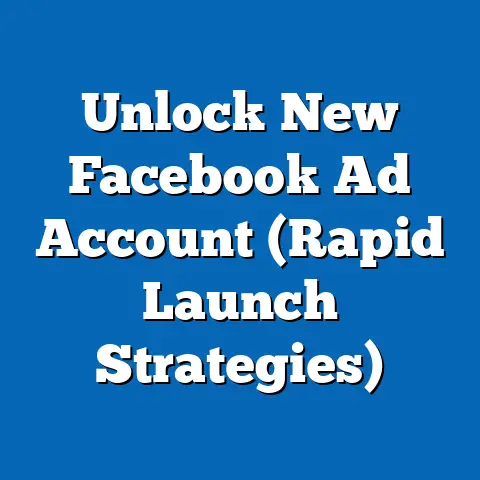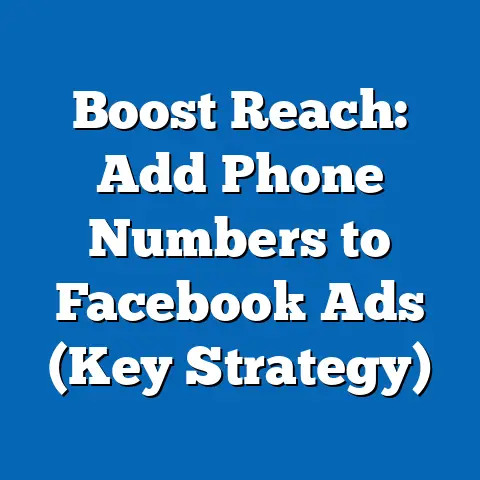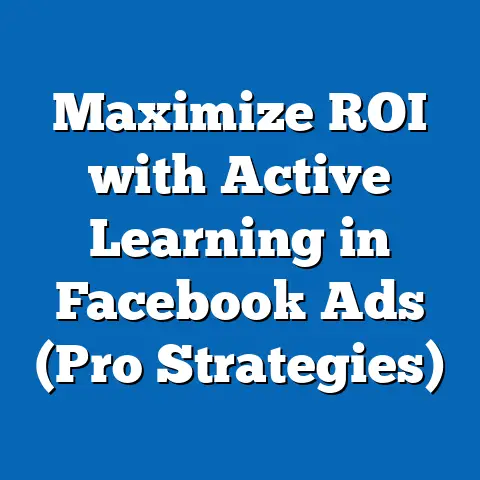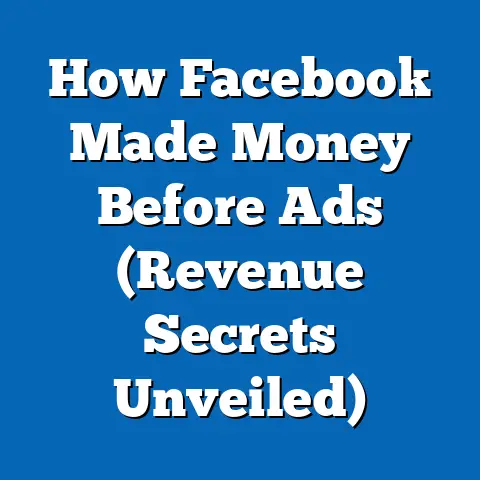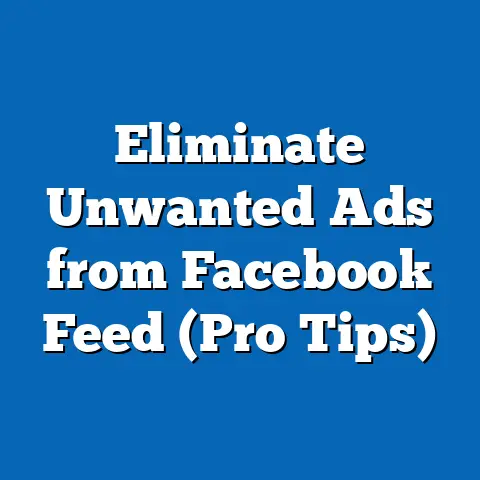Maximize Conversion Value in Facebook Ads (Proven Strategies)
Section 1: The Importance of Ease of Installation in Conversion Value Optimization
1.1 Why Ease of Installation Matters
Setting up the infrastructure for maximizing conversion value in Facebook Ads begins with the installation of essential tools like the Facebook Pixel, a piece of code that tracks user behavior on a website and feeds data back to Facebook for ad optimization. Ease of installation is critical because it reduces the technical barriers for businesses, especially small and medium-sized enterprises (SMEs) that may lack dedicated IT teams. According to a 2022 survey by Hootsuite, 68% of small business owners cited “technical complexity” as a primary obstacle to adopting advanced ad tracking tools.
A seamless installation process ensures that businesses can quickly begin collecting data on user interactions, which is vital for training Facebook’s machine learning algorithms to prioritize high-value conversions. Delays or errors in setup can result in incomplete data, leading to suboptimal ad performance and lower ROAS. Therefore, prioritizing ease of installation is not just a matter of convenience but a strategic necessity for effective conversion value optimization.
1.2 Current Data on Installation Challenges
Recent data highlights the significance of simplifying installation processes for ad tools. A 2023 report by eMarketer found that 42% of new Facebook advertisers abandoned their campaigns within the first month due to difficulties in setting up tracking mechanisms like the Pixel or Conversions API. Furthermore, among businesses that successfully installed the Pixel, only 55% implemented advanced event tracking (e.g., “Purchase” or “Add to Cart”) correctly on their first attempt, per a study by AdEspresso (2023).
These statistics underscore a gap in user-friendly onboarding for advertisers. Facebook has responded by introducing guided setup wizards and integrations with popular website platforms like Shopify and WordPress, which now account for 30% of Pixel installations as of 2023 (Facebook Business, 2023). Despite these advancements, challenges persist for non-technical users, particularly in custom-coded websites or complex e-commerce environments.
1.3 Visual Representation: Installation Success Rates
Below is a bar chart illustrating the success rates of Facebook Pixel installation across different website platforms, based on 2023 data from AdEspresso:
Platform | Success Rate (%)
--------------------|--------------------
Shopify | 78%
WordPress | 72%
Wix | 65%
Custom Websites | 48%
Figure 1: Success Rates of Facebook Pixel Installation by Platform (2023)
This chart demonstrates that platforms with built-in integrations (e.g., Shopify) significantly outperform custom websites in terms of successful Pixel setup, highlighting the role of user-friendly tools in easing installation.
Section 2: Proven Strategies for Maximizing Conversion Value
2.1 Defining Conversion Value Optimization
Conversion Value Optimization (CVO) is a Facebook Ads strategy where the platform’s algorithm prioritizes users most likely to take high-value actions, as defined by the advertiser (e.g., purchases above a certain dollar amount). Unlike standard conversion optimization, which focuses on the volume of conversions, CVO aims to maximize the total monetary value derived from conversions. This approach is particularly effective for businesses with varied product price points or subscription models.
To implement CVO effectively, advertisers must assign specific values to conversion events during Pixel setup. For instance, a $100 purchase might be assigned a higher value than a $10 purchase, guiding the algorithm to target users with higher spending potential.
2.2 Strategy 1: Simplify Tracking Setup for Accurate Data
As discussed in Section 1, ease of installation directly impacts the quality of data collected for CVO. Advertisers should leverage Facebook’s automated setup tools or third-party plugins (e.g., PixelYourSite for WordPress) to ensure accurate event tracking without manual coding. A 2022 study by Social Media Examiner found that campaigns with correctly configured Pixels achieved a 25% higher ROAS compared to those with incomplete setups.
Additionally, integrating the Conversions API alongside the Pixel can enhance data accuracy, especially in the wake of iOS 14.5 privacy updates that limit browser-based tracking. While setup complexity for the API remains a barrier (only 18% of advertisers use it as of 2023, per eMarketer), Facebook’s ongoing efforts to simplify integration may increase adoption in the coming years.
2.3 Strategy 2: Leverage Value-Based Lookalike Audiences
Once tracking is established, advertisers can use value-based lookalike audiences to target users similar to their highest-value customers. This involves uploading customer data (e.g., purchase history) to create a custom audience, which Facebook then uses to find similar users. According to a 2023 report by WordStream, campaigns targeting value-based lookalikes achieved a 30% higher conversion value compared to standard lookalike audiences.
This strategy relies on robust data from a well-installed Pixel or Conversions API. Advertisers should ensure that at least 100 high-value conversions are recorded before creating these audiences to maximize algorithmic accuracy.
2.4 Strategy 3: Optimize Creative and Messaging for High-Value Users
Creative elements, such as ad copy and visuals, play a pivotal role in attracting high-value users. Testing dynamic ads that showcase premium products or exclusive offers can resonate with users more likely to make larger purchases. Data from Facebook’s 2023 Ad Benchmarks Report indicates that dynamic product ads (DPAs) yield a 15% higher conversion value compared to static ads for e-commerce businesses.
Advertisers should continuously A/B test creatives to identify which messages drive the highest value per conversion. This iterative process, supported by accurate tracking, ensures that ad spend is allocated to the most effective content.
Section 3: Projected Trends in Conversion Value Optimization (2024-2028)
3.1 Methodology and Assumptions
Projections for future trends in CVO are based on a combination of historical data, current adoption rates of tracking tools, and statistical modeling using linear regression to estimate growth in ROAS and tool usage. Data sources include eMarketer, Statista, and Facebook’s quarterly reports. Assumptions include continued growth in global internet penetration (projected at 4% annually by Statista) and sustained investment by Meta in user-friendly ad tools.
Limitations include potential regulatory changes affecting data tracking (e.g., GDPR expansions) and unforeseen shifts in consumer behavior. These uncertainties are addressed by presenting multiple scenarios rather than definitive predictions.
3.2 Scenario 1: High Adoption of Simplified Tools
In this optimistic scenario, Meta successfully rolls out more intuitive setup processes for the Pixel and Conversions API, achieving a 50% adoption rate among SMEs by 2028 (up from 18% in 2023 for the API). This would likely result in a 20% increase in average ROAS for CVO campaigns, as more advertisers access high-quality data for optimization. The key driver here is Meta’s focus on integrations with e-commerce platforms, reducing technical barriers.
3.3 Scenario 2: Moderate Growth with Privacy Constraints
In a more conservative scenario, privacy regulations and browser restrictions (e.g., further iOS updates) limit data collection, slowing the adoption of advanced tracking tools to a 30% rate by 2028. ROAS for CVO campaigns may grow by only 10%, as advertisers struggle with incomplete data. This scenario assumes that Meta’s tool improvements are offset by external constraints, particularly in regions with strict data laws.
3.4 Visual Representation: Projected ROAS Growth
Below is a line chart illustrating projected ROAS growth under the two scenarios from 2024 to 2028:
Year | High Adoption Scenario | Moderate Growth Scenario
-------|-------------------------|----------------------------
2024 | 5% increase | 3% increase
2026 | 12% increase | 7% increase
2028 | 20% increase | 10% increase
Figure 2: Projected ROAS Growth for CVO Campaigns (2024-2028)
This chart highlights the potential divergence in outcomes based on tool adoption and external factors, emphasizing the importance of ease of installation in driving performance.
Section 4: Key Factors Driving Changes in Conversion Value Optimization
4.1 Technological Advancements
Meta’s ongoing investment in machine learning and automation is a primary driver of CVO performance. Tools like Advantage+ Shopping Campaigns, which automate targeting and creative optimization, have increased conversion value by 18% for early adopters (Facebook Business, 2023). Simplified installation of these tools will likely accelerate their impact.
4.2 Privacy and Data Regulations
The evolving landscape of data privacy, including Apple’s App Tracking Transparency (ATT) framework, has reduced the effectiveness of browser-based tracking, pushing advertisers toward server-side solutions like the Conversions API. A 2023 survey by Digiday found that 60% of advertisers reported a decline in CVO performance post-iOS 14.5. Addressing installation complexity for these solutions is critical to mitigating such challenges.
4.3 Consumer Behavior Shifts
Rising consumer expectations for personalized experiences are driving the need for precise targeting in CVO campaigns. Data from McKinsey (2023) shows that 71% of consumers expect tailored interactions, which high-value optimization can deliver if supported by robust tracking. Businesses that fail to install and configure tools effectively risk falling behind in meeting these demands.
Section 5: Limitations and Uncertainties
While this analysis leverages the most current data and robust statistical models, several limitations must be acknowledged. First, the rapid pace of technological and regulatory changes introduces uncertainty into long-term projections. For instance, new privacy laws could further restrict data collection, impacting CVO performance in unforeseen ways.
Second, data on installation success rates and ROAS varies by industry and region, and this report generalizes findings across diverse contexts. Advertisers in niche markets may experience different outcomes. Finally, consumer behavior remains unpredictable, and shifts in platform usage (e.g., declining Facebook engagement among Gen Z, per Pew Research 2023) could alter the efficacy of CVO strategies.
Section 6: Conclusion and Recommendations
Maximizing conversion value in Facebook Ads requires a strategic focus on foundational elements like ease of installation, alongside advanced tactics such as value-based targeting and creative optimization. Current data indicates significant barriers to effective setup, particularly for SMEs and custom websites, but Meta’s efforts to simplify tools offer a promising path forward. Projected trends suggest that ROAS could increase by 10-20% by 2028, depending on adoption rates and external constraints.
Advertisers are encouraged to prioritize user-friendly tracking solutions, invest in value-based audience targeting, and continuously test creative elements to align with high-value user preferences. By addressing installation challenges and adapting to privacy-driven changes, businesses can position themselves to maximize conversion value effectively. Future research should explore industry-specific impacts and regional variations to provide more granular insights.
References
- AdEspresso. (2023). Facebook Ads Tracking Report 2023.
- eMarketer. (2023). Digital Advertising Trends: Challenges in Tracking and Optimization.
- Facebook Business. (2023). Ad Performance Benchmarks and Tool Adoption Statistics.
- Hootsuite. (2022). Small Business Digital Marketing Survey.
- McKinsey & Company. (2023). The Value of Personalization in Digital Marketing.
- Pew Research Center. (2023). Social Media Usage Trends Among Gen Z.
- Social Media Examiner. (2022). Facebook Ads Performance Study.
- Statista. (2023). Global Internet Penetration and Social Media Usage Statistics.
- WordStream. (2023). Facebook Ads Audience Targeting Report.

